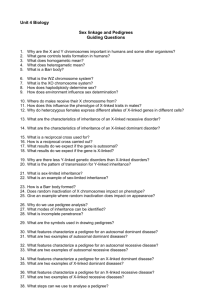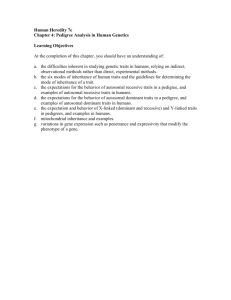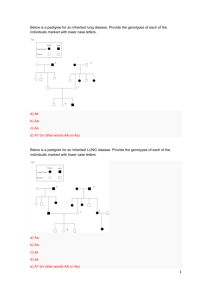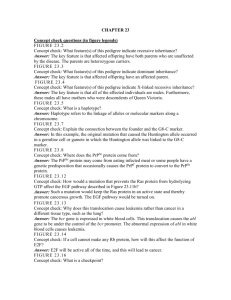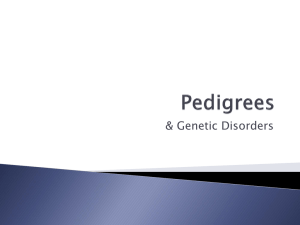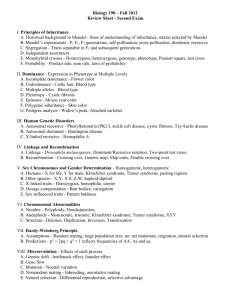4-Pedigree Analysis - International University For Science
advertisement
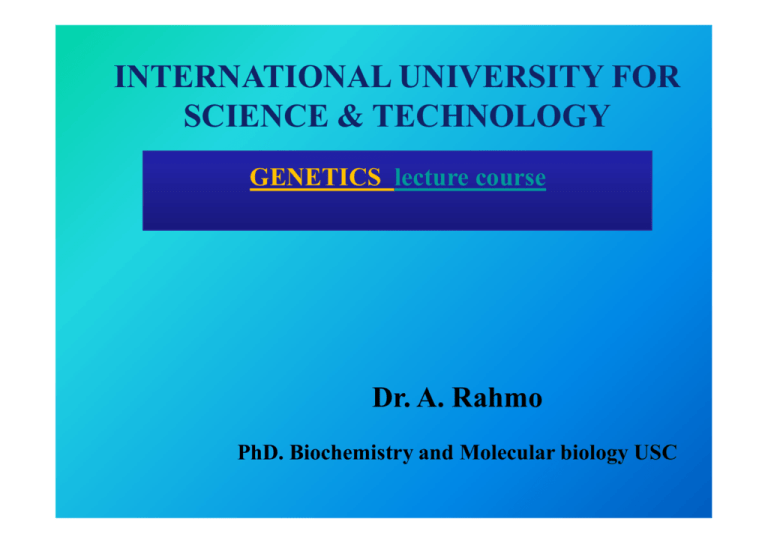
INTERNATIONAL UNIVERSITY FOR SCIENCE & TECHNOLOGY GENETICS lecture course Dr. A. Rahmo PhD. Biochemistry and Molecular biology USC GENETICS COURSE LECTURES 1- INTRODUCTION 2- MONOGENIC INHERITANCE (ONE GENE) 3- MONOGENIC INHERITANCE (TWO GENES) 4- PEDIGREE ANALYSIS 5- BEYOND CLASSICAL (MENDELIAN) GENETICS 6- EXAM 7-POLYGENIC INHERITANCE 8- CYTOGENETICS 9- MOLECULAR GENETICS OF PROCARYOTES 10- MOLECULAR GENETICS OF EUCARYOTES 11- ONCOGENETICS 12- EXAM 13- TESTING & TREATMENT OF GENETIC DISEASES 14- POPULATION GENETICS 15- REVIEW PEDIGREE ANALYSIS Classical (Mendelian) Genetics Pedigrees symbolic representations of family relationships and inheritance of a trait Normal female Normal male Pedigrees symbolic representations of family relationships and inheritance of a trait Single bar indicates mating Normal parents and normal offspring Single parent means partner is not significant for the analysis Double bar indicates consanguineous mating Fraternal twins (not identical) Pedigrees symbolic representations of family relationships and inheritance of a trait Identical twins 2 6 Number of children Affected Heterozygote Female X-linked carrier Dead Aborted or stillborn Effect of consanguinity The Royal Egyptian family A Pedigree with Consanguinity Effect of consanguinity DD DD Dd Dd DD Dd Dd DD Dd DD Dd DD dd Consanguinity increases the risk of sharing a common ancestral mutation Congenital Insensitivity to Pain (congenital analgesia): is one or more rare conditions where a person cannot feel (and has never felt) physical pain Sclerosteosis A rare genetic disorder characterized by syndactyly (condition where two or more digits are fused together) and thickening and overgrowth of bone. interferance with a process which plays a key role in the regulation of bone formation. autosomal recessive Autosomal Traits Albinism Autosomal Recessive Inheritance Brachydactyly "shortness of the fingers and toes" (digits) Autosomal Dominant Inheritance Achondroplasia is a bone-growth disorder responsible for 70% of dwarfism cases, the limbs are disproportionally short compared to the trunk (abdominal area), with the head larger than normal and characteristic facial features. Autosomal Dominant Chands Syndrome CHAND is an acronym for Curly HairAnkyloblepharon-Nail Dysplasia syndrome. This combination of anomalies belongs to the group of ectodermal dysplasias and has been described in less than five patients. Autosomal recessive Tay-Sachs Disease known as infantile Tay–Sachs disease, it causes a relentless deterioration of mental and physical abilities that commences around six months of age and usually results in death by the age of four. Autosomal Recessive; Lethal before reproduction Freckles Freckles are clusters of concentrated melanin which are most often visible on people with a fair complexion. Autosomal Dominant X-linked Recessive Traits Always expressed in hemizygous males Female homozygotes show the trait but female heterozygotes do not Affected males: Inherited from affected or heterozygous mother Affected females : affected fathers and affected or heterozygous mothers Possible genotypes X+Y Hemizygous wild type male XmY Hemizygous mutant male X+X+ Homozyogus wild female X+Xm Heterozygous female carrier XmXm Homozygous mutant female Ichtyosis All types of ichthyosis have dry, thickened, scaly or flaky skin.[1] In many types the skin is said to resemble the scales on a fish X-linked Recessive Inheritance HEMOPHILIA A (clotting factor VIII deficiency) Colorblindness Colorblindness is a defect of vision affecting the ability to distinguish colors, occurring mostly in males. Color blindness is caused by a defect in the retina or in other nerve portions of the eye. Also known as dichromatism, this disease consists of the inability to differentiate between reds and greens. X-linked recessive X-linked dominant trait What does the pattern look like? Affected female Affected male Normal male Normal female Example with male survival X-linked dominant, male lethal What does the pattern look like? Affected female Normal male Normal female Example with male lethality X-linked dominant recurrence risks Mother X1 X1 Y X1X1 X1Y X2 X1X2 Daughters 50% normal 50% affected X2Y Sons 50% normal 50% affected Congenital Generalized Hypertrichosis describes hair growth on the body in an amount considered abnormal. Extensive cases of hypertrichosis have informally been called werewolf syndrome. X-linked Dominant Inheritance Incontinentia pigmenti Linear blisters on leg Linear erosions on soles • • • • • • • Linear blisters in newborn girls “Crops” followed by scarring Small teeth Eye abnormalities Patchy hair loss Only girls are affected Males are typically not affected X-linked dominant (male lethal condition) Potentially confusing in X-linked pedigree analysis • • • • Male lethal X-linked conditions New mutations may be hard to recognize as X-linked Sex-limited conditions may look X-linked With carrier mother and affected father can see “male to male” inheritance Y-linked Traits • • • • • Genes on the Y chromosome Very rare Transmitted male to male No affected females Currently, identified Y-linked traits involve infertility and are not transmitted Example: Y chromosome infertility Codominant Alleles Punnett squares Offspring from Parents with Blood Type A and Blood Type B ABO blood typing: co-dominant alleles A/- -/- B/- A/- AB AB A/- B/- BB B/- BB BB EXERCISES What type of inheritance is present in this Pedigree? Inconclusive EXERCISES Genetic Predictions Ellen’s brother Michael has sickle cell anemia, an autosomal recessive disease. - What is the probability that Ellen’s child has a sickle cell anemia allele? Ellen and Michael’s parents must be heterozygous S •Probability Ellen is a carrier = 2/3 •Probability child inherits sickle cell allele = ½ •Probability child carries sickle cell allele from Ellen = 2/3 x 1/2 = 1/3 s S SS Ss s Ss ss Ellen is not affected and cannot be ss EXERCISES 1 Question #1 2 Write the genotypes in every possible place. If individuals 1 and 2 marry, what is the probability that their first child will be sick? EXERCISES Question #2 • PKU is a human hereditary disease resulting from inability of the body to process the chemical phenylalanine (contained in protein that we eat). • It is caused by a recessive allele with simple Mendelian inheritance. • Some couple wants to have children. The man has a sister with PKU and the woman has a brother with PKU. There are no other known cases in their families. • What is the probability that their first child will have PKU ? ٣٤ EXERCISES Question #2-Solution Highlights P/p P/p P/p P/p p/p P/- P/- p/p P – the normal allele p – the mutant allele Answer: 1/9 EXERCISES Question #3 The disease is rare. 1 2 3 4 5 6 7 8 a. What is the most likely mode of inheritance ? b. What would be the outcomes of the cousin marriages 1 x 9, 1 x 4, 2 x 3, and 2 x 8 ? 9 10 EXERCISES Question #3-Solution Highlights a. Observations: – – b. After the disease is introduced into the family in generation #2, it appears in every generation dominant! Fathers do not transmit the phenotype to their sons X-linked! The outcomes: – – – – 1 x 9: 1 must be A/a 9 must be A/a 1 x 4: 1 must be A/a 4 must be a/a 2 x 3: 2 must be a/a 3 must be A/a 2 x 8: 2 must be a/a 8 must be a/a Same All normal ٣٧ EXERCISES What is the probability that a clinically unaffected sibling of a child with an autosomal recessive disease is a carrier for that disorder ? EXERCISES What is the probability that the consultand III-3 is a carrier of Duchenne muscular dystrophy ? • • • • • 1 2 3 4 5 1/2 1/4 1/8 1/9 1/18 EXERCISES EXERCISES EXERCISES EXERCISES EXERCISES Solutions to the exercises REVIEW OF PROBABILITY RULES Definition of Probability • The probability of an event equals the number of times it happens divided by the number of opportunities. • These numbers can be determined by experiment or by knowledge of the system. • For instance, rolling a die (singular of dice). The chance of rolling a 2 is 1/6, because there is a 2 on one face and a total of 6 faces. So, assuming the die is balanced, a 2 will come up 1 time in 6. • It is also possible to determine probability by experiment: if the die were unbalanced (loaded = cheating), you could roll it hundreds or thousands of times to get the actual probability of getting a 2. For a fair die, the experimentally determined number should be quite close to 1/6, especially with many rolls. The AND Rule of Probability • The probability of 2 independent events both happening is the product of their individual probabilities. • Called the AND rule because “this event happens AND that event happens”. • For example, what is the probability of rolling a 2 on one die and a 2 on a second die? For each event, the probability is 1/6, so the probability of both happening is 1/6 x 1/6 = 1/36. • Note that the events have to be independent: they can’t affect each other’s probability of occurring. An example of non-independence: you have a hat with a red ball and a green ball in it. The probability of drawing out the red ball is 1/2, same as the chance of drawing a green ball. However, once you draw the red ball out, the chance of getting another red ball is 0 and the chance of a green ball is 1. The OR Rule of Probability • The probability that either one of 2 different events will occur is the sum of their separate probabilities. • For example, the chance of rolling either a 2 or a 3 on a die is 1/6 + 1/6 = 1/3. The NOT Rule of Probability • The chance of an event not happening is 1 minus the chance of it happening. • For example, the chance of not getting a 2 on a die is 1 - 1/6 = 5/6. • This rule can be very useful. Sometimes complicated problems are greatly simplified by examining them backwards. Combining the Rules • More complicated situations involve combining the AND and OR rules. • It is very important to keep track of the individuals involved and not allow them to be confused. This is the source of most people’s problems with probability. • What is the chance of rolling 2 dice and getting a 2 and a 5? The trick is, there are 2 ways to accomplish this: a 2 on die A and a 5 on die B, or a 5 on die A and a 2 on die B. Each possibility has a 1/36 chance of occurring, and you want either one or the other of the 2 events, so the final probabilty is 1/36 + 1/36 = 2/36 = 1/18.

